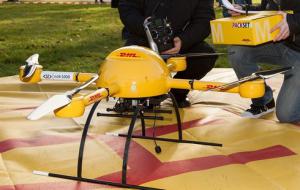ISISISIS using drones with explosives, spy cameras: Pentagon
The Pentagon says that ISIS fighters are have been posing a growing threat to U.S. and Iraqi forces by using small commercial drones to carry improvised explosives devices (IEDs) or surveillance cameras. These drones are especially threatening because they can evade detection. The growing threat led the Joint Improvised-Threat Defeat Agency, the Pentagon’s office charged with keeping tab on and countering IEDs, to ask Congress for permission to reallocate $20 million to provide money for a counter-drone program.

If drones can deliver packages, they can deliver explosives // Source: theconversation.com
The Pentagon says that ISIS fighters are have been posing a growing threat to U.S. and Iraqi forces by using small commercial drones to carry improvised explosives devices (IEDs) or surveillance cameras.
These drones are especially threatening because they can evade detection. The Washington Times reports that the growing threat led the Joint Improvised-Threat Defeat Agency, the Pentagon’s office charged with keeping tab on and countering IEDs, to ask Congress for permission to reallocate $20 million to provide money for a counter-drone program.
The funds would be used to “identify, acquire, integrate and conduct testing” of technologies which would “counter the effects of unmanned aerial systems and the threats they pose to U.S. forces,” according to a budget document sent to Congress last week. The document was part of a broader request by the Pentagon to be permitted to shift $2.5 billion in defense appropriations approved for this year from their original purposes to other programs.
Analysts note that the request reflects the reality that commercially available drone technology has now reached beyond the hobbyist community to adversaries of the United States. The Pentagon, in its latest annual report on Iran’s military capabilities, said, for example, that Iran is fielding armed drones among other “increasingly lethal weapon systems.” Around the Pentagon, the police has posted “no drone” signs, along with the more common “no photos” warnings.
The Pentagon’s budget document notes that in the fight against ISIS, “small and tactical unmanned aerial systems” equipped with improvised explosive devices, or IEDs, “pose a direct threat to U.S. and coalition forces,” according to the budget document.
“Just days after the Iraqi forces began occupying Makhmour in Ninevah Province, a video surfaced” on an ISIS Web site “showing forces on the ground there, demonstrating they were using the footage in both reconnaissance and propaganda roles,” Army Colonel Chris Garver, the Defense Department’s top spokesman in Iraq, told the Telegraph.
The Joint Improvised-Threat Defeat Agency has seen ISIS fly “quadcopters and fixed-wing type drones you can buy commercially” as “both an IED delivery system and for reconnaissance,” the agency’s spokesman, David Small, told the Teegraph.
The commercial drones used by ISIS have weighed about 50 pounds or less, Small said.
Small noted that in addition to drones with full-motion video looking for attack opportunities and monitoring Iraqi Security Forces, ISIS uses the drones to provide target information for vehicles carrying suicide bombs.
Small said, “there is a wide array of technology angles we are looking into” to defeat the drones which would be deployed within two years, if not sooner.
